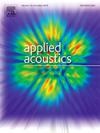A novel method for detecting bearing faults in induction motors using acoustic sensors and feature engineering
IF 3.4
2区 物理与天体物理
Q1 ACOUSTICS
引用次数: 0
Abstract
The study and development of fault diagnosis techniques for induction motors (IMs) have received significant attention, particularly regarding bearing failures. Although acoustic signals have been explored in the recent literature, advances in research about the quantity and model of sensors are still needed, as well as to develop approaches for extracting and selecting information that facilitates fault identification. In this context, this paper presents a new methodology to extract specific acoustic features from IMs and identify early-stage bearing distributed faults, which is unexplored in electric machine faults studies. It involves acoustic signals collected from multiple sensors, which are selected through similarity tests, and identifies the most crucial features to diagnose fault conditions using Recursive Feature Extraction and Random Forest as selectors. These selection methods highlight relevant features for the diagnostic process, improve fault identification, and reduce computational effort, resulting in a final accuracy rate of 98.86%. Identification of distributed and incipient bearing failures is achieved by using the selected features and comparing different classifiers and results in the literature. For this purpose, five sensors were used at a distance of 30 centimeters from the IM housing, and their signals were conditioned using electronic gain with operational amplifiers. The results demonstrate the system's applicability in low-noise environments such as test and inspection laboratories and IM out-of-operation testers. The methodology can be suitable for embedded systems, due to the reduction of attribute sets for fault identification.
求助全文
约1分钟内获得全文
求助全文
来源期刊

Applied Acoustics
物理-声学
CiteScore
7.40
自引率
11.80%
发文量
618
审稿时长
7.5 months
期刊介绍:
Since its launch in 1968, Applied Acoustics has been publishing high quality research papers providing state-of-the-art coverage of research findings for engineers and scientists involved in applications of acoustics in the widest sense.
Applied Acoustics looks not only at recent developments in the understanding of acoustics but also at ways of exploiting that understanding. The Journal aims to encourage the exchange of practical experience through publication and in so doing creates a fund of technological information that can be used for solving related problems. The presentation of information in graphical or tabular form is especially encouraged. If a report of a mathematical development is a necessary part of a paper it is important to ensure that it is there only as an integral part of a practical solution to a problem and is supported by data. Applied Acoustics encourages the exchange of practical experience in the following ways: • Complete Papers • Short Technical Notes • Review Articles; and thereby provides a wealth of technological information that can be used to solve related problems.
Manuscripts that address all fields of applications of acoustics ranging from medicine and NDT to the environment and buildings are welcome.
 求助内容:
求助内容: 应助结果提醒方式:
应助结果提醒方式:


